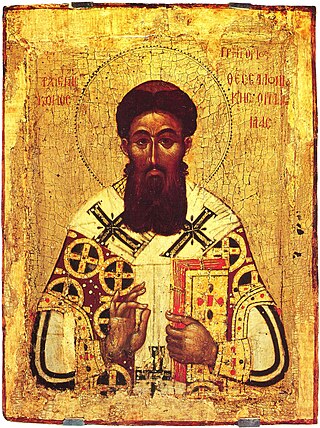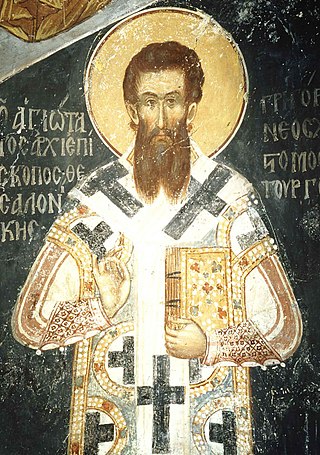Related Research Articles

Benedict of Nursia, often known as Saint Benedict, was an Italian Christian monk, writer, and theologian. He is venerated in the Catholic Church, the Eastern Orthodox Church, the Oriental Orthodox Churches, the Anglican Communion, and Old Catholic Churches. In 1964 Pope Paul VI declared Benedict a patron saint of Europe.

Gregory of Nazianzus, also known as Gregory the Theologian or Gregory Nazianzen, was a 4th-century archbishop of Constantinople and theologian. He is widely considered the most accomplished rhetorical stylist of the patristic age. As a classically trained orator and philosopher, he infused Hellenism into the early church, establishing the paradigm of Byzantine theologians and church officials.

Hesychasm is a contemplative monastic tradition in the Eastern Christian traditions of the Eastern Catholic Churches and Eastern Orthodox Church in which stillness (hēsychia) is sought through uninterrupted Jesus prayer. While rooted in early Christian monasticism, it took its definitive form in the 14th century at Mount Athos.

Year 595 (DXCV) was a common year starting on Saturday of the Julian calendar. The denomination 595 for this year has been used since the early medieval period, when the Anno Domini calendar era became the prevalent method in Europe for naming years.

Pope Adeodatus I, also called Deodatus I or Deusdedit, was the bishop of Rome from 19 October 615 to his death. He was the first priest to be elected pope since John II in 533. The first use of lead seals or bullae on papal documents is attributed to him. His feast day is 8 November.

Gregory Palamas was a Byzantine Greek theologian and Eastern Orthodox cleric of the late Byzantine period. A monk of Mount Athos and later archbishop of Thessaloniki, he is famous for his defense of hesychast spirituality, the uncreated character of the light of the Transfiguration, and the distinction between God's essence and energies. His teaching unfolded over the course of three major controversies, (1) with the Italo-Greek Barlaam between 1336 and 1341, (2) with the monk Gregory Akindynos between 1341 and 1347, and (3) with the philosopher Gregoras, from 1348 to 1355. His theological contributions are sometimes referred to as Palamism, and his followers as Palamites.

Basil of Caesarea, also called Saint Basil the Great, was a bishop of Caesarea Mazaca in Cappadocia, Asia Minor. He was an influential theologian who supported the Nicene Creed and opposed the heresies of the early Christian church, fighting against both Arianism and the followers of Apollinaris of Laodicea.

Doctor of the Church, also referred to as Doctor of the Universal Church, is a title given by the Catholic Church to saints recognized as having made a significant contribution to theology or doctrine through their research, study, or writing.

Dionysius the Areopagite was an Athenian judge at the Areopagus Court in Athens, who lived in the first century. A convert to Christianity, he is venerated as a saint by multiple denominations.

The Melkite Greek Catholic Church, or Melkite Byzantine Catholic Church, is an Eastern Catholic church in full communion with the Holy See as part of the worldwide Catholic Church. Its chief pastor is Patriarch Youssef Absi, headquartered at the Cathedral of Our Lady of the Dormition in Damascus, Syria. The Melkites, who are Byzantine Rite Catholics, trace their history to the early Christians of Antioch, formerly part of Syria and now in Turkey, of the 1st century AD, where Christianity was introduced by Saint Peter.
Western Rite Orthodoxy, also called Western Orthodoxy or the Orthodox Western Rite, are congregations within the Eastern Orthodox tradition which perform their liturgy in Western forms.

In Eastern Orthodox Christian theology, the Tabor Light is the light revealed on Mount Tabor at the Transfiguration of Jesus, identified with the light seen by Paul at his conversion.

Palamism or the Palamite theology comprises the teachings of Gregory Palamas, whose writings defended the Eastern Orthodox practice of Hesychasm against the attack of Barlaam. Followers of Palamas are sometimes referred to as Palamites.

The Diocese of Latina-Terracina-Sezze-Priverno is a Latin Church ecclesiastical territory or diocese of the Catholic Church in Lazio, Italy. It was established under this name in 1986. It is the continuation of the Diocese of Terracina, Priverno e Sezze, whose existence was confirmed by Pope Honorius III in 1217, as a joining of the Diocese of Terracina with the Diocese of Priverno and the Diocese of Sezze under a single bishop. It is immediately exempt to the Holy See.

The Catholic Church and the Eastern Orthodox Church have been in a state of official schism from one another since the East–West Schism of 1054. This schism was caused by historical and language differences, and the ensuing theological differences between the Western and Eastern churches.

November 4 - Eastern Orthodox liturgical calendar - November 6

November 9 - Eastern Orthodox liturgical calendar - November 11

The 1086 papal election ended with the election of Desiderius, abbot of Monte Cassino as Pope Gregory VII's successor after a year-long period of sede vacante.

The Church Fathers, Early Church Fathers, Christian Fathers, or Fathers of the Church were ancient and influential Christian theologians and writers who established the intellectual and doctrinal foundations of Christianity. The historical period in which they worked became known as the Patristic Era and spans approximately from the late 1st to mid-8th centuries, flourishing in particular during the 4th and 5th centuries, when Christianity was in the process of establishing itself as the state church of the Roman Empire.

March 14 - Eastern Orthodox liturgical calendar - March 16